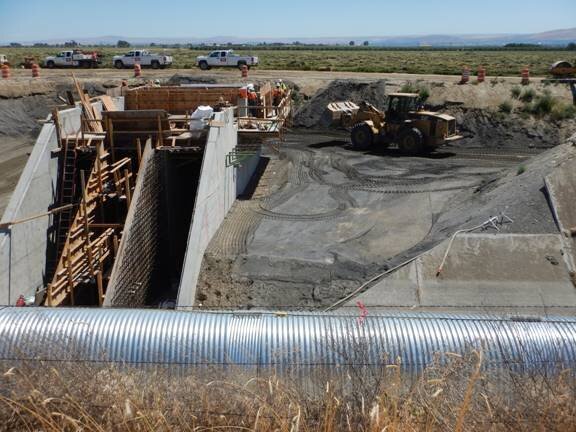By: John O’Callaghan
Assistant Manager, South Columbia Basin Irrigation District















South Columbia Basin Irrigation District (District) has long been interested in pumping water from the Esquatzel Diversion Canal (EDC) into the Pasco Pump Lateral (PPL). The EDC and the PPL cross each other just east of where the EDC returns project waste, seepage and return flows to the Columbia River. The PPL receives water from the tail end of the Potholes Canal, serving Block 1, and frequently would face water shortages during peak demand.
Taking advantage of Bonneville Power Administration’s Energy Smart Reserve Power Program, the District received an incentive payment of $1.52M to build a new pumping plant, called the PPL1.6 Pumping Plant. The District directly funded another $3.51M for a total project cost of $5.03M. The District contracted with RH2 Engineering to provide project management, design and construction management services. Apollo Inc. of Kennewick, Washington was the low bidder and construction began in January, 2017 and the plant was commissioned in October, 2017. There were numerous challenges encountered during the design and construction of this project and the success thereof was largely due to the efforts of both RH2 and Apollo.
In order for the plant to receive project reserve power, the facilities design and construction had to be approved by the Bureau of Reclamation. Upon completion of the plant and associated facilities, facility title, or ownership, is transferred to Reclamation, which then transfers the operation and maintenance of the facilities back to the District.
The PPL1.6PP entered regular service in April, 2018 and provided about two-thirds of the demand in Block 1 during the first few years of operation. As with any new large piece of operational infrastructure, a period of developing operational experience has been required. The District expects to deliver nearly all of the Block 1 irrigation demand, approximately 30,000-acre feet, via the new pumping plant beginning in 2019.
Benefits of this project include reducing the demand on the Potholes Canal thereby relieving conveyance pressure, reducing water diversions out of the Columbia River at Grand Coulee Dam, ensuring water supply for Block 1, and improving tail end water management during aquatic herbicide applications. It is worth noting that the PPL1.6PP is the largest water conservation project constructed on the CBP to date. Additionally, with large scale urbanization taking place in the Block 1 service area, the PPL1.6PP provides greater operational flexibility for an aged lateral system facing new requirements.




